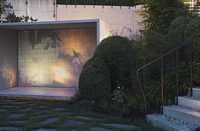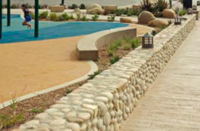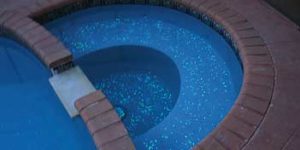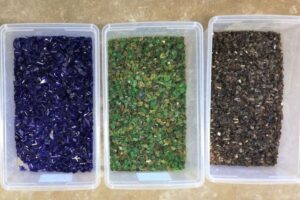Tom Ralston of Tom Ralston Concrete in Santa Cruz, California, returned home as the winningest recipient of the eighth annual Decorative Concrete Awards competition sponsored by the Decorative Concrete Council, a specialty council of the American Society of Concrete Contractors. The awards were presented during a ceremony at the World of Concrete 2016 in Las Vegas.
The often-praised and ever-likeable contractor won three first-place awards: one for Cast-in-Place Special Finishes, Over 5,000 Square Feet, for the Aruba Residence; and two for the Santa Cruz Roundabout, one for Multiple Applications, Under 5,000 Square Feet, and another for Best Project Video.
The city of Santa Cruz’s Public Works Department also entered the roundabout in a California competition and the project won the “Best Streetscape” for the entire state.
Art with function
Almost exactly a year in the making, the roundabout in front of the Santa Cruz Wharf near the city’s boardwalk features “leaping” dolphins going round and round pointing the way for traffic to proceed. “Think of a surfer in baggies helping traffic along as he says, ‘Just follow the dolphins, dude!’” says Ralston with a chuckle.
Expanding on the nautical theme, traffic islands around the roundabout centerpiece resemble windswept sand dunes with smooth weatherworn rock covered and bared by the tides. Some of the rocks, Ralston says, are flipped up to resemble dorsal fins. Others look like outcroppings on a windswept cliff, only twisting in somewhat of a serpentine way.
To convince the public works people to approve his roundabout proposal, “I had to show them mock ups, which were expensive,” but they ultimately served their purpose and got TRC the green light to proceed.
Once underway, the challenges continued, with traffic the primary sticking point. “This was a four-way stop that led to the beach boardwalk, the wharf and to the scenic West Cliff Drive,” Ralston says. Since as many as 50,000 visitors drive through and around this area on weekends, “The area had to remain open to traffic so traffic control was an issue.”
To further complicate matters, he and his crew had to deal with hecklers who were not in favor of the project. “Some said the city was wasting taxpayer money, so it was somewhat political. Some of the people were angry and would scream expletives at me and the other workers as we worked.”
Aesthetically, the dolphins are decorated with beach glass, seashells, aquarium sand and a custom hand-ground abalone eye. They were acid stained to give them a variegated look and sealed with the best sealer for the job.
The dolphins were cast off-site in TRC’s yard with a propriety mix design, “And, knock on wood, they are holding up perfectly,” Ralston says. “We had to build them strong enough to be driven over by large, heavy trucks.” Three different sized dolphins are in the roundabout, 4-, 6- and 8-foot versions, with the 8-foot replicas weighing almost 1,000 pounds.
They had to be trucked to the roundabout and then craned in starting at dark so traffic would be less of an issue. “We made break-away forms so that when we lifted the dolphins only two pieces of plywood remained for the straps that surrounded them for hoisting,” Ralston says. The dolphins were strategically placed on pillars that sloped toward the street to allow a proprietary mix to flow around and under each one for additional strength and support.
Surrounding the roundabout, 12 islands of various shapes and sizes are fashioned out of a proprietary concrete mix. Each is acid stained in multiple colors and contains starfish, shells, small pebbles and a mix of large flat rock. Acid-stained veins on most of these steep-graded surfaces make them look like vertical concrete, Ralston notes. “To make veins that would not run down in errant patterns everywhere, we had to develop a staining system.”
When the project was completed last July, its beauty and functionality won over a significant number of naysayers. “I believe we exceeded the expectations of the community, which feels great,” Ralston says. “Concrete has provided an art piece with function.”
Perfect movie material
Ralston says he intuitively knew the Santa Cruz Roundabout was going to be an extraordinary, one-of-a-kind project so he made arrangements to have it videotaped from the very beginning just for posterity.
“The project started with the dolphin tables and then the plastic molds, 30 in all,” he says. The project included such Kodak moments as a crane installing dolphins, and he and his crew making large concrete ‘sand dune’ mounds with ‘dorsal fin’ rocks meandering throughout. Acid staining and sealing the stained concrete also produced some incredible shots.
“The entire project from beginning to end screamed for video!” he says. And the timing was just too perfect when he learned the ASCC/DCC was adding a “best video” category to its annual competition. Entering was a no brainer, Ralston says. “We thought: Yup, we’re doin’ this.”
Ralston says he’d like to extend a special thank you to all involved, especially his talented friend, Jeff Luhn, for cobbling together his own video shots with TRC’s to produce the award-winning clip.
Project in paradise
The Aruba residence that earned Ralston his third award is a true gem. The job on the north shore of the island came with a scenic view, but there were challenges beyond mustering up the desire to work hard while staring at a tropical beach all day. Not only does the home’s owner own a concrete facility, he also owns a four-star hotel on the island, where Ralston’s crew stayed, and is a beverage distributor.
That all sounds nice, but because of the heat, they were placing concrete at “zero dark 30,” Ralston says. “We would pour at dark and then we would tarp everything to keep the sun off of it and it was really challenging. When we poured inside the house we tarped that too. We made the whole house as dark as a mushroom factory, like a cave, so we could keep the sun off of it to help us with the curing.”
The residence owner was demanding in his desire for perfection. After a fellow concrete professional suggested Ralston, he flew there for extensive interviews with the architect before getting the job. The first conversations took place in April 2012, he visited the owner in October 2012, and concrete was placed in October 2013. Ralston worked with seven of his own guys and up to 12 men with all different South American and Caribbean accents. The crew went to Aruba five times between October 2013 and April 2014 and finished on Easter Sunday 2014.
The home itself is 16,000 square feet of concrete — 8,000 for the interior (4,000 downstairs and 4,000 upstairs), and 4,000 in front of the house and 4,000 in back — in particular blends of three different colors. “One of the things the architect wanted was a house that had light colors because of the heat, and he wanted it with a bluish tint,” Ralston explains. “We used these light grays and Dover blues and medium gray and blended them in different ratios for the pool deck, lower floor and upper floor.”
Ralston had to make sure each time he visited the island that he took with him all of the specialty tools and materials he would need, from brushes to buckets. Everything outside was acid washed while the interior was lightly sanded. Ralston spent about $12,000 on color and shipping costs for something like 300 buckets of color.
The owners and architects wanted a floor that was nearly seamless, which is risky because without adequate joints the floor cannot expand or contract without cracking, so Ralston fabricated his own tool to make tiny, inconspicuous saw cuts. “When the water dissipates from the concrete it shrinks so when it shrinks it has a real strong likelihood or tendency to form plastic shrinkage cracks,” he says.
Ralston, who strongly dislikes small aggregate, used a larger aggregate than most contractors normally would. “Small aggregate lends itself to plastic shrinking,” he explains. “Smaller aggregate takes up less mass so you actually have to add more sand to the mix design to make up for that. More sand typically means more water is needed to allow for workability and thus there is a likelihood of more shrinkage. There’s less shrinkage in a bigger aggregate mix.”





















